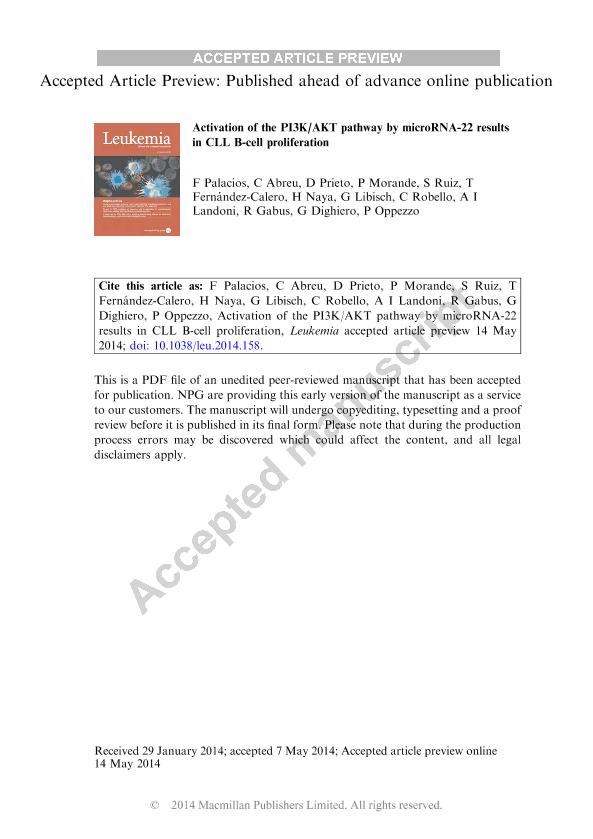Artículo
Activation of the PI3K/AKT pathway by microRNA-22 results in CLL B-cell proliferation
Palacios, F.; Abreu, C.; Prieto, D.; Morande, Pablo Elías ; Ruiz, S.; Fernández Calero, T.; Naya, H.; Libisch, G.; Robello, C.; Landoni, A. I.; Gabus, R.; Dighiero, G.; Oppezzo, Pablo
; Ruiz, S.; Fernández Calero, T.; Naya, H.; Libisch, G.; Robello, C.; Landoni, A. I.; Gabus, R.; Dighiero, G.; Oppezzo, Pablo
 ; Ruiz, S.; Fernández Calero, T.; Naya, H.; Libisch, G.; Robello, C.; Landoni, A. I.; Gabus, R.; Dighiero, G.; Oppezzo, Pablo
; Ruiz, S.; Fernández Calero, T.; Naya, H.; Libisch, G.; Robello, C.; Landoni, A. I.; Gabus, R.; Dighiero, G.; Oppezzo, Pablo
Fecha de publicación:
01/2015
Editorial:
Nature Publishing Group
Revista:
Leukemia
ISSN:
0887-6924
Idioma:
Inglés
Tipo de recurso:
Artículo publicado
Clasificación temática:
Resumen
Chronic lymphocytic leukemia (CLL) is characterized by accumulation of clonal B cells arrested in G0/G1 stages that coexist, in different proportions, with proliferative B cells. Understanding the crosstalk between the proliferative subsets and their milieu could provide clues on CLL biology. We previously identified one of these subpopulations in the peripheral blood from unmutated patients that appears to be a hallmark of a progressive disease. Aiming to characterize the molecular mechanism underlying this proliferative behavior, we performed gene expression analysis comparing the global mRNA and microRNA expression of this leukemic subpopulation, and compared it with their quiescent counterparts. Our results suggest that proliferation of this fraction depend on microRNA-22 overexpression that induces phosphatase and tensin homolog downregulation and phosphoinositide 3-kinase (PI3K)/AKT pathway activation. Transfection experiments demonstrated that miR-22 overexpression in CLL B cells switches on PI3K/AKT, leading to downregulation of p27-Kip1 and overexpression of Survivin and Ki-67 proteins. We also demonstrated that this pathway could be triggered by microenvironment signals like CD40 ligand/interleukin-4 and, more importantly, that this regulatory loop is also present in lymph nodes from progressive unmutated patients. Altogether, these results underline the key role of PI3K/AKT pathway in the generation of the CLL proliferative pool and provide additional rationale for the usage of PI3K inhibitors.
Archivos asociados
Licencia
Identificadores
Colecciones
Articulos(SEDE CENTRAL)
Articulos de SEDE CENTRAL
Articulos de SEDE CENTRAL
Citación
Palacios, F.; Abreu, C.; Prieto, D.; Morande, Pablo Elías; Ruiz, S.; et al.; Activation of the PI3K/AKT pathway by microRNA-22 results in CLL B-cell proliferation; Nature Publishing Group; Leukemia; 29; 1; 1-2015; 115-125
Compartir
Altmétricas



